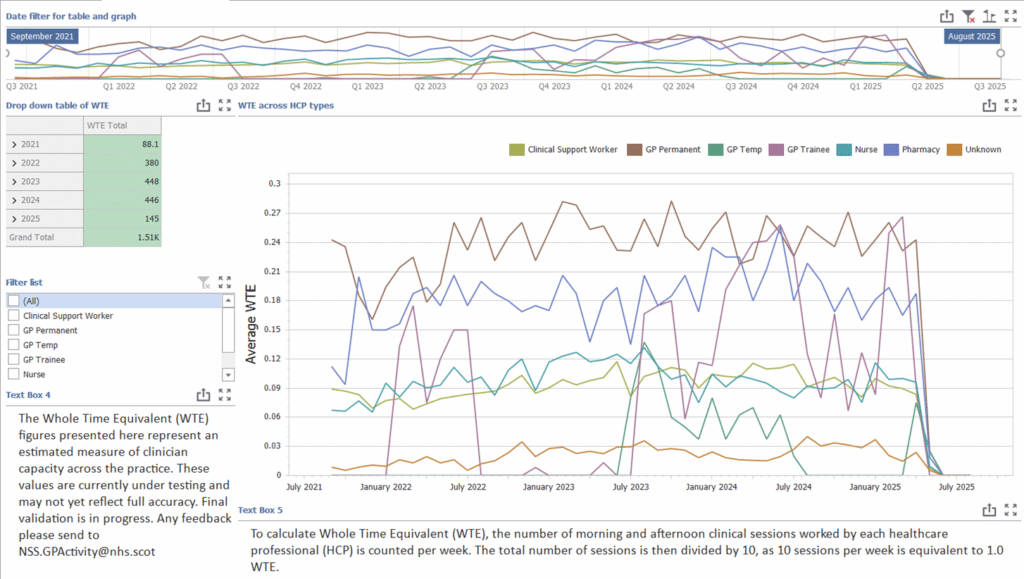In-Hours Activity Practice Dashboard – V2
A new version of the in-practice dashboard is available for download by all practices from September 2025: In-hours Dashboard. The new release includes two additional functions which are outlined below.
Whole Time Equivalent
The Whole Time Equivalent (WTE) tab shows the estimated measure of clinician capacity across the practice. To calculate Whole Time Equivalent (WTE), the number of morning and afternoon clinical sessions worked by each healthcare professional (HCP) is counted per week. The total number of sessions is then divided by 10 (with 10 sessions per week being taken as equivalent to 1.0 WTE).
These values are currently under testing and may not yet reflect full accuracy. Please send any feedback to NSS.GPActivity@nhs.scot.

Continuity of Care
The Continuity of Care tab shows a standard and adapted version of the St Leonard’s Index of Continuity of Care (SLICC). The standard version uses the preferred GP as recorded in the GPIT system, the adapted version uses the usual provider over care (UPC).
We wish to acknowledge the invaluable input from the St Leonard’s Research Practice, Exeter in providing expert opinion on development of the continuity measures.
In the image below, the graph on the left shows the average UPC score across clinicians, reflecting how consistently patients see the same provider. Higher values indicate stronger continuity of care. For example, a clinician with a UPC score of 0.6 means that, on average, their patients saw them for 60% of their visits, with the remaining 40% being with other providers.

For calculation of Usual Provider of Care (UPC):
• Usual provider of care will be determined by the most commonly seen doctor for each patient over the past 2 years. Only active clinicians in the GPIT system will be included to avoid clinicians from a patient’s previous practice being included.
• 3 or more direct consultations within the past 2 years
• Of these patients must have at least two consultations with most commonly seen doctor.
For calculation of standard SLICC:
• 1 or more direct consultations (telephone consultations, face to face, home visits e-consultations) over the preceding calendar month.
• Numerator and denominator are for consultations with any doctor e.g. FYs, GP trainees, GPs.
• SLICC is the proportion of included patient encounters in the practice list with contact with usual GP over the preceding calendar month.
For calculation of aSLICC (modified SLICC):
• 1 or more direct consultations (telephone consultations, face to face, home visits e-consultations) over the preceding calendar month.
• Numerator and denominator are for consultations with any doctor e.g. FYs, GP trainees, GPs.
• aSLICC is the proportion of included patient encounters in the practice list with contact with UPC over the preceding calendar month.
User Guide
A number of other small changes were introduced alongside the new functionality mentioned above. The full detail of each change is captured in the updated user guide which is available to download below:
Both new measures described above are being released for testing/feedback, and may not yet reflect full accuracy. The new continuity measurement is part of a suite of work that is in progress to enable and support practices to prioritise relational continuity of care in the longer term. If you wish to provide any feedback from your practice, please email to NSS.GPActivity@nhs.scot